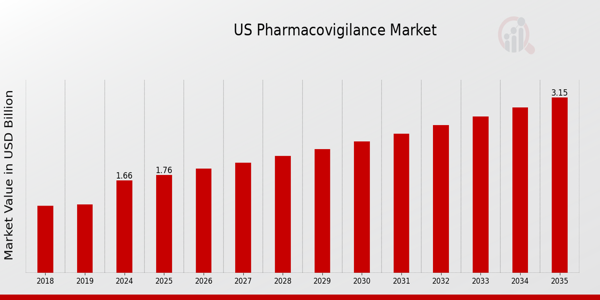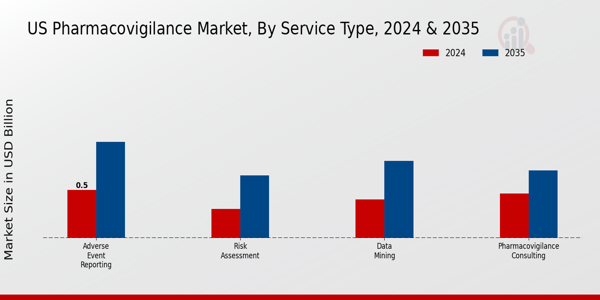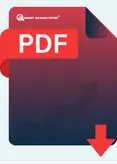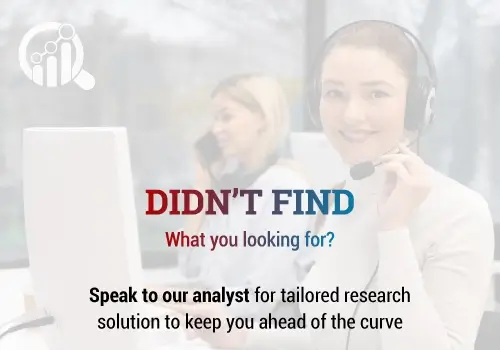US Pharmacovigilance Market Overview
As per MRFR analysis, the US Pharmacovigilance Market Size was estimated at 1.56 (USD Billion) in 2023. The US Pharmacovigilance Market is expected to grow from 1.66 (USD Billion) in 2024 to 3.15 (USD Billion) by 2035. The US Pharmacovigilance Market CAGR (growth rate) is expected to be around 6.002% during the forecast period (2025 - 2035)
Key US Pharmacovigilance Market Trends Highlighted
The growing focus on patient safety and regulatory compliance is driving notable changes in the US pharmacovigilance market. The strict rules set by the Food and Drug Administration (FDA) and other regulatory agencies, which demand ongoing drug safety monitoring, are one of the main factors propelling the market.
To make sure they follow the law and stay out of trouble, pharmaceutical companies have been encouraged by this obligation to invest in cutting-edge pharmacovigilance technologies. Furthermore, the necessity for strong surveillance systems to efficiently track adverse drug responses has increased due to consumer knowledge and demand for the safe use of drugs.
The US market offers a wealth of opportunities, particularly for technologically advanced solutions. Businesses can more quickly identify safety warnings by analysing large volumes of data more effectively through the incorporation of artificial intelligence and machine learning into pharmacovigilance operations.
This change in technology is opening the door for creative approaches and procedures that can improve the effectiveness of reporting and monitoring. Furthermore, pharmacovigilance duties are increasingly being outsourced, giving smaller businesses access to first-rate services without having to deal with the hassle of complex in-house operations.
Real-time monitoring and data integration from several sources, such as social media and electronic health records, are becoming more popular, according to recent trends. In the US, where more and more stakeholders are concentrating on post-marketing surveillance to learn more about medication safety outside of clinical trials, this trend is especially pertinent.
A patient-centric approach to pharmacovigilance is made possible by the increasing use of patient-reported outcomes. With an emphasis on technology, regulatory compliance, and patient safety, the US pharmacovigilance market is generally changing, underscoring the growing complexity and vital significance of drug safety monitoring in this area.

Source: Primary Research, Secondary Research, Market Research Future Database and Analyst Review
US Pharmacovigilance Market Drivers
Increasing Regulatory Compliance and Safety Monitoring
The US Pharmacovigilance Market is witnessing robust growth driven by the increasing necessity for regulatory compliance and enhanced safety monitoring of medications. The US Food and Drug Administration (FDA) has been emphasizing stricter safety protocols to ensure that any adverse effects on patients are promptly reported and addressed.
According to the FDA, the introduction of the Risk Evaluation and Mitigation Strategies (REMS) program has led to a more rigorous approach towards drug safety, amplifying the responsibilities placed on pharmaceutical companies.
As a result, the demand for effective pharmacovigilance solutions is surging. The growing trend toward more complex healthcare regulations requires that pharmaceutical companies maintain detailed and accurate drug safety data, leading to a projected increase in the use of pharmacovigilance systems in the United States to manage these responsibilities effectively.
This push for compliance creates a significant market opportunity for pharmacovigilance service providers and technology innovators alike.
Technological Advancements in Pharmacovigilance Systems
The integration of advanced technologies like Artificial Intelligence (AI) and Machine Learning (ML) into pharmacovigilance practices is transforming the US Pharmacovigilance Market. According to the FDA, the adoption of AI-enabled systems has the potential to improve drug safety surveillance by enhancing data analysis and speeding up the identification of adverse drug reactions.
For instance, AI technologies can process vast amounts of data from clinical trials and post-market studies, enabling faster and more efficient vigilance efforts. With increasing investments in Research and Development (R&D) for such technologies, leading organizations in the pharmaceutical sector are better equipped to meet safety regulations while also reducing operational costs.
Rising Incidence of Chronic Diseases
The growing burden of chronic diseases in the United States, such as diabetes and cardiovascular ailments, is driving demand for effective pharmacovigilance practices.
The Centers for Disease Control and Prevention (CDC) report that approximately 6 in 10 adults in the US live with at least one chronic disease, which necessitates a robust pharmacovigilance framework to monitor the side effects of numerous medications used in treatment.
As pharmaceutical companies are compelled to manage complex therapies and monitor long-term drug effects, the need for enhanced vigilance increases significantly. This surge in necessity ensures that organizations providing pharmacovigilance services will continue experiencing growth in the years to come.
US Pharmacovigilance Market Segment Insights
Pharmacovigilance Market Service Type Insights
The US Pharmacovigilance Market is a vital component of the healthcare sector, focusing on the safety and efficacy of pharmaceutical products through various Service Types. Among these, Adverse Event Reporting plays a crucial role, helping organizations collect, assess, and analyze data regarding negative reactions to medications.
This process ensures that any safety concerns are quickly addressed, thereby protecting patient welfare and enhancing drug reliability. Risk Assessment services evaluate the potential risks associated with pharmaceutical products, taking into consideration data from extensive clinical studies and real-world experiences.
This service contributes significantly to regulatory compliance and is increasingly critical in the context of stringent US Food and Drug Administration requirements. Data Mining is increasingly becoming an integral part of the Pharmacovigilance landscape in the US, utilizing advanced analytical techniques to sift through large volumes of healthcare data.
This assists organizations in identifying trends and potential safety signals that may not be apparent through traditional reporting methods, ultimately leading to proactive measures for risk management.
Pharmacovigilance Consulting services are also gaining traction in this market, providing specialized expertise to firms navigating the complexities of regulatory compliance, developing safety protocols, and implementing effective pharmacovigilance systems.
In terms of trends, the increasing emphasis on patient safety and risk management in the pharmaceutical industry is driving growth across all service types. Additionally, advanced technologies such as artificial intelligence and machine learning are being integrated into these services to improve data processing and risk detection capabilities.
The ongoing study of drug interactions and post-marketing surveillance further fuels the necessity for comprehensive service offerings in the US Pharmacovigilance Market. Overall, as the landscape evolves, the significance of each Service Type within the market grows, showcasing the impact of a robust pharmacovigilance framework in safeguarding public health.

Source: Primary Research, Secondary Research, Market Research Future Database and Analyst Review
Pharmacovigilance Market Deployment Mode Insights
The Deployment Mode segment of the US Pharmacovigilance Market plays a crucial role in ensuring the safety and efficacy of pharmaceutical products. With the increasing focus on compliance with stringent regulatory standards, organizations are witnessing a shift in their operational frameworks.
Cloud-Based solutions have become increasingly popular due to their flexibility and scalability, allowing quicker access to data and collaboration across geographically dispersed teams. Meanwhile, On-Premise solutions continue to dominate in sectors where data security and control are paramount, particularly among large enterprises managing sensitive information.
The integration of advanced technologies such as artificial intelligence and machine learning within these deployment modes is enhancing data analysis capabilities, driving more effective risk management strategies in the industry.
As the US government emphasizes the importance of patient safety and vigilance through robust pharmacovigilance practices, the deployment modes are pivotal in supporting these objectives. This landscape presents significant opportunities for growth, ensuring stakeholders can adapt to emerging trends while overcoming challenges such as data privacy and integration complexities.
Pharmacovigilance Market Source Insights
The Source segment of the US Pharmacovigilance Market plays an essential role in ensuring drug safety and monitoring adverse events. Spontaneous Reporting is a particularly significant component, as it allows healthcare professionals and patients to report adverse drug reactions directly, providing valuable real-world data.
This method encourages a broad base of input, crucial for identifying rare side effects not captured during clinical trials. On the other hand, Literature Reports involve systematic reviews of published studies, enabling regulators and pharmaceutical companies to stay abreast of findings related to drug safety.
This source is vital for assessing the risk-benefit profile of medications amidst the ever-evolving medical literature. Scheduled Reporting encompasses routine safety checks that pharmaceutical companies must conduct, reinforcing a proactive approach to Pharmacovigilance.
Each of these components plays a pivotal role in US regulations, with significant emphasis placed on gathering comprehensive US Pharmacovigilance Market data to uphold safety standards.
Alongside this dynamic framework, ongoing advancements in technology and increasing governmental scrutiny are driving growth in the US Pharmacovigilance Market, presenting both challenges and opportunities for industry players.
Pharmacovigilance Market End-user Insights
The End-user segment of the US Pharmacovigilance Market plays a critical role in ensuring drug safety and efficacy while significantly influencing the overall market dynamics. Pharmaceutical Companies, representing a substantial portion of the segment, focus on rigorous safety monitoring to comply with regulatory requirements and enhance product life cycles, enhancing consumer trust and loyalty.
Biotechnology Companies are pivotal due to their innovation-driven nature, contributing to advanced pharmacovigilance practices that effectively address unique safety concerns associated with biologics.
Contract Research Organizations (CROs) serve as strategic partners for numerous pharmaceutical and biotechnology firms, facilitating compliance with regulatory frameworks while assisting in streamline safety assessments and reporting processes.
The collaboration between these entities fosters a robust environment for data collection and analysis, ultimately benefiting public health in the United States.
The increasing emphasis on patient safety and adverse event reporting further reinforces the importance of these End-users in the broader Pharmacovigilance landscape, indicating a sustained growth trajectory characterized by continuous advancements in technology and regulation.
US Pharmacovigilance Market Key Players and Competitive Insights
The US Pharmacovigilance Market has seen significant growth, driven by the increasing need for drug safety monitoring and regulatory compliance. As the healthcare landscape continues to evolve with a focus on patient safety and effective risk management, the competitive environment for pharmacovigilance services has become more pronounced.
Various stakeholders, including pharmaceutical companies, clinical research organizations, and software service providers, are actively engaging in the market to enhance their offerings and improve the efficiency of adverse event reporting.
The demand for real-time data analysis and risk assessment is pushing companies to adopt advanced technologies and innovative solutions, further intensifying competition and driving market dynamics.
Oracle stands out significantly in the US Pharmacovigilance Market, primarily due to its strong market presence and comprehensive suite of software solutions tailored for safety and risk management in pharmaceuticals. Its strengths include a robust technology platform that supports end-to-end pharmacovigilance processes, including case management, regulatory reporting, and signal detection.
Oracle’s ability to integrate its offerings with existing systems is highly valued among clients, helping to streamline operational workflows and enhance data accuracy. The company’s commitment to innovation through continuous upgrades and responsive customer support further solidifies its position as a leader in the market.
Additionally, Oracle benefits from extensive experience with regulatory compliance, enabling organizations to navigate complex legislative environments effectively.
In the context of the US Pharmacovigilance Market, Medpace is recognized for its specialized range of services and expertise in drug development and regulatory affairs. The company provides integrated solutions that encompass clinical development, regulatory submission support, and specialized pharmacovigilance services aimed at ensuring the safety of investigational and marketed products.
Medpace's strengths lie in its deep understanding of various therapeutic areas, allowing it to tailor its pharmacovigilance services to meet the unique requirements of its clients. Furthermore, the company has strategically enhanced its capabilities through a series of mergers and acquisitions, positioning itself as a full-service clinical research organization.
This strategy not only strengthens its market presence but also expands its service offerings to clients, making Medpace a key player in the US pharmacovigilance landscape. Its dedication to quality, compliance, and customer satisfaction has earned it a solid reputation in the industry, supporting its growth and client retention efforts.
Key Companies in the US Pharmacovigilance Market Include
US Pharmacovigilance Market Developments
The US Pharmacovigilance Market has witnessed significant developments, especially with increased regulatory scrutiny and a focus on patient safety. Companies like Oracle and IQVIA have reported expansions in their pharmacovigilance services to enhance drug safety monitoring.
In September 2023, Medpace announced the acquisition of a niche pharmacovigilance consultancy, bolstering its capabilities in risk management services. Parexel and Syneos Health have also collaborated to improve data analytics in pharmacovigilance, aiming for more efficient regulatory compliance.
Veeva Systems and ArisGlobal have been enhancing their software solutions to provide better automation in the adverse event reporting process, responding to the evolving needs of the industry. The US Food and Drug Administration has prompted an increase in life cycle management practices for drug safety data, which has generated opportunities for companies like Covance and Celerion.
The market continues to show growth potential, driven by technological advancements and heightened demand for effective monitoring of drug safety profiles. The last two years have also seen regulatory changes, pushing firms to invest more in pharmacovigilance infrastructure, ensuring compliance with evolving guidelines.
Pharmacovigilance Market Segmentation Insights
-
Pharmacovigilance Market Service Type Outlook
- Pharmacovigilance Consulting
-
Pharmacovigilance Market Deployment Mode Outlook
-
Pharmacovigilance Market Source Outlook
-
Pharmacovigilance Market End-user Outlook
| Report Attribute/Metric |
Details |
| Market Size 2023 |
1.56(USD Billion) |
| Market Size 2024 |
1.66(USD Billion) |
| Market Size 2035 |
3.15(USD Billion) |
| Compound Annual Growth Rate (CAGR) |
6.002% (2025 - 2035) |
| Report Coverage |
Revenue Forecast, Competitive Landscape, Growth Factors, and Trends |
| Base Year |
2024 |
| Market Forecast Period |
2025 - 2035 |
| Historical Data |
2019 - 2024 |
| Market Forecast Units |
USD Billion |
| Key Companies Profiled |
Oracle, Medpace, Parexel, Syneos Health, EPHMRA, IQVIA, Veeva Systems, Celerion, Wuxi AppTec, Bioclinica, Covance, ArisGlobal, Avoca Group, Veristat, Pharmerit International |
| Segments Covered |
Service Type, Deployment Mode, Source, End-user |
| Key Market Opportunities |
AI-driven data analysis tools, enhanced regulatory compliance solutions, Real-time safety monitoring systems, Integration of big data analytics, and Expansion in contracted pharmacovigilance services |
| Key Market Dynamics |
Regulatory compliance requirements, Growing adverse event reporting, Increasing focus on patient safety, Advancements in technology, Rise in drug recalls |
| Countries Covered |
US |
Frequently Asked Questions (FAQ):
The US Pharmacovigilance Market was valued at 1.66 billion USD in 2024.
By 2035, the US Pharmacovigilance Market is projected to reach a value of 3.15 billion USD.
The market is expected to have a CAGR of 6.002% during the forecast period from 2025 to 2035.
Adverse Event Reporting is anticipated to have the highest value, expected to reach 1.0 billion USD in 2035.
Risk Assessment was valued at 0.3 billion USD in the year 2024.
Key players in the market include Oracle, Medpace, Parexel, Syneos Health, and IQVIA, among others.
Data Mining is expected to be valued at 0.8 billion USD in 2035.
Pharmacovigilance Consulting was worth 0.46 billion USD in 2024.
The market presents opportunities driven by advancements in technology and increasing regulatory requirements.
The market is expected to grow at a rate of 6.002% during the forecast period from 2025 to 2035.
















